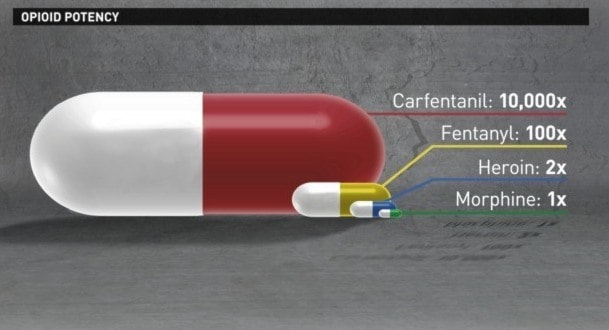The deadly drug carfentanil has reached the Interior.
There was a positive carfentanil drug test in the Kootenay region reported by Health Canada and a positive carfentanil urine test in the Thompson Cariboo Shuswap region reported by LifeLabs. The drugs tested by Health Canada were illegal imitation oxycodone tablets with the markings CDN 80. The drug involved in the positive urine test is unknown.
“These recent findings confirm our suspicions and anecdotal reports that carfentanil is present in IH communities,” said Dr. Trevor Corneil, Chief Medical Health Officer with Interior Health, in a press release.
“Carfentanil has also been detected in other parts of B.C. and may be responsible for the spike in overdose deaths seen at the end of 2016.”
RELATED: DRUG DEATH NUMBERS CONTINUE TO RISE
Carfentanil is a synthetic opioid normally used as a sedative for large animals like elephants. It is similar to fentanyl but can be 100 times more toxic; one or two grains the size of salt grains can be fatal to humans.
There is no reliable way for people to know with certainty if fentanyl, carfentanil or other potentially toxic components are in illegal drugs. People who use drugs are advised to abstain when possible, or to take measures to prevent overdose. Overdoses caused by carfentanil require larger quantities of naloxone and are more likely to be lethal.
Not using drugs at all is the best way to avoid overdose and other health impacts. Interior Health recommends people abstain from using any type of illegal drug, if at all possible. If abstaining is not an option, the following tips can help reduce the risk of overdose:
- Don’t mix different drugs (including pharmaceutical medications, street drugs, and alcohol)
- Don’t take drugs when you are alone, have a sober buddy with you. Leave door unlocked. Tell someone to check on you.
- Use less and pace yourself. Do testers to check strength - take a small sample of a drug before taking your usual dosage.
- Keep an eye out for your friends – stay together and look out for each other.
- Carry a Naloxone kit and know how to use it. A list of locations to get a kit can be found on the Interior Health website.
- Recognize the signs of an OD: Slow or no breathing, gurgling or gasping, lips/fingertips turning blue, difficult to rouse (awaken), non-responsive.
- If someone thinks they may be having an overdose or is witnessing an overdose, follow the SAVE ME steps and call 9-1-1 immediately, do not delay.
For more resources and links related to overdose and substance use, visit: interiorhealth.ca
